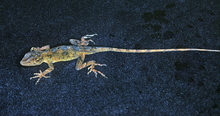Anolis hobartsmithi, also known commonly as Hobart Smith's anole, the north Chiapas anole, and el abanquillo de Hobart Smith in Mexican Spanish, is a species of lizard in the family Dactyloidae. The species is native to Mexico.[2]
| Anolis hobartsmithi | |
|---|---|

| |
| Scientific classification | |
| Domain: | Eukaryota |
| Kingdom: | Animalia |
| Phylum: | Chordata |
| Class: | Reptilia |
| Order: | Squamata |
| Suborder: | Iguania |
| Family: | Dactyloidae |
| Genus: | Anolis |
| Species: | A. hobartsmithi
|
| Binomial name | |
| Anolis hobartsmithi Nieto-Montes de Oca, 2001
| |
Etymology
editThe specific name, hobartsmithi, is in honor of American herpetologist Hobart Muir Smith.[3]
Geographic range
editA. hobartsmithi is endemic to the Mexican state of Chiapas.[1][2]
Habitat
editThe preferred natural habitat of A. hobartsmithi is forest, but it has also been found in agricultural areas.[1] The holotype was collected at an altitude of about 2,000 m (6,600 ft).[2]
Reproduction
editReferences
edit- ^ a b c Muñoz-Alonso, A. (2007). "Anolis hobartsmithi ". IUCN Red List of Threatened Species. 2007: e.T64197A12747051. doi:10.2305/IUCN.UK.2007.RLTS.T64197A12747051.en. Retrieved 19 November 2021.
- ^ a b c d Species Anolis hobartsmithi at The Reptile Database www.reptile-database.org.
- ^ Beolens, Bo; Watkins, Michael; Grayson, Michael (2011). The Eponym Dictionary of Reptiles. Baltimore: Johns Hopkins University Press. xiii + 296 pp. ISBN 978-1-4214-0135-5. (Anolis hobartsmithi, p. 124).
Further reading
edit- Heimes P (2022). Lizards of Mexico. Part I. Iguanian lizards. Herpetofauna Mexicana Vol. 2. Frankfurt am Main, Germany: Edition Chimaira. 480 pp. ISBN 978-3-89973-101-9.
- Nieto-Montes de Oca A (2001). "The systematics of Anolis hobartsmithi (Squamata: Polychrotidae), another species of the Anolis schiedii group from Chiapas, Mexico". In: Johnson JD, Webb RG, Flores-Villela OA (2021). Mesoamerican Herpetology: Systematics, Zoogeography, and Conservation. El Paso, Texas: University of Texas at El Paso. 200 pp. (Anolis hobartsmithi, new species).
